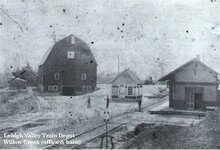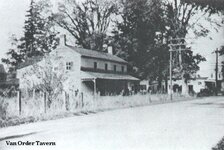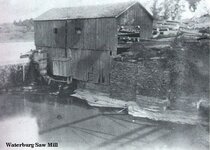Gypsy Heart
Gold Member
In 1000 B.C. to 1600 A.D. the Iraquois Indian Culture developed. It is part of this culture that the indians in Ulysses belonged. There were two groups of Indians living in this area that were intermingled, and called themselves Ganungueuguchi, that is Senecayugas. These Indians were both Cayugas and Senecas, the chief settlement of the former being between Perry and Mecklenburgh, while that of the Senecas was between Pratt's and Tannerville.
This union was brought about, for the most part, by an aspiring and talented young chief whose father was a Seneca and whose mother was a Cayuga. The name of the chief of the community was derived from Ganuridesaga (Seneca Lake), and Guenguch (Cayuga Lake). Gantinguenguch was the Indian name of the chief, the settlements, the people, the stream, and of the falls."
Of the early Jacksonville settlers were Thomas Cooper, and his grandson, Jeremiah, who came here by ox team from Connecticut in 1799. The journey took 4 weeks and Jerimiah was 8 years old at the time. Thomas cleared a tract of land and the next year Jeremiah's father came on with the family. They later built an inn that served as a stagecoach stop on the Ithaca and Geneva Turnpike (Trumansburg Road or Rte. 96) in 1823.
Jacksonville, earlier known as Van Cortlandt Village was named after Col. Philip Van Cortlandt, a prominent soldier, who like many Revolutionary War veterans of the time drew a tract of land in the form of lots as payment for service to his country. Mr. Van Cortlandt visited other war compatriots in the area including Abner Treman who was 12 years younger and had served under him. Philip Van Cortlandt was born in New York City August 21, 1749. He pursued classical studies and attended Coldenham Academy and was later engaged as a civil engineer. He was a member of the Provincial Congress in 1775 and during the Revolutionary War served as lieutenant colonel. Philip was mustered out of the service with the rank of brigadier general for gallant conduct at the siege of Yorktown under General Lafayette and was delegate to the State ratification convention in 1788. He was a member of the State assembly from 1788-1790 and served in the State senate from 1791-1793. He was elected to the Third Congress and reelected as a Republican to the seven succeeding Congresses (March 4, 1793-March 3, 1809) and was engaged in agricultural pursuits. He died at Van Cortlandt Manor, Croton on Hudson, Westchester County, N.Y., on November 21, 1831; interment in Hillside Cemetery, Peekskill, N.Y.
A striking portrait of Philip Van Cortlandt by Ezra Ames may be found in the Metropolitan Museum of Art. Ezra Ames had studied the "Stuart" style in Hudson and painted many of the elite families of the time. Included in the 500 portraits of Ezra's tenure were Philips brother Pierre and his sister Anne which are part of the Van Cortlandt collection at VanCortlandt Manor.
Jacksonville later became known as "Harlows Corners". Shortly after the Battle of New Orleans in 1815, the name was changed to Jacksonville in honor of "Old Hickory" President Andrew Jackson.
The Cooper Inn served as the first Post Office, established February 25, 1820 with Henry S. Granger appointed first postmaster. In the 1860's it was run by J.M. Stout and later it was moved to each of the general stores during different times. Postmaster Mildred Baker served the longest; she was appointed November 16, 1937 and moved the post office to her home. The present building was constructed and dedicated in 1962. Clarmarie S. Kenerson who succeeded Mrs. Baker was appointed January 12, 1962 and was assisted by Doris Swartwood.
The first school meeting was held in 1811, though the construction date of the schoolhouse is unknown. The last classes were taught in 1962.
The Jacksonville Methodist Church was incorporated in 1826, and the first building (since moved to Jacksonville Rd.) was built shortly afterwards in 1827. In the 1860's Michael Coyle was Pastor. The present church was built on the same site in 1898.
The Ulysses Grange #419 was chartered in 1877, and met for 100 years. They built a hall in 1911, which today is known as Close Hall located across the street from the present Methodist Church.
Being mostly farmland, people spent time cutting and marketing hay, evolving from earlier grain growing. Soil here can be described as gravelly loam which is conducive to grain and grass growing. Cayuga Lake travel was very active before the train depots were established.
There was a lead pipe factory in operation in Jacksonville for about a decade from 1830, and potash was manufactured in earlier years. Later there were two blacksmith shops one run by Chas Van Duyn the other by Chas Taylor.
A tavern in the community was built by John Mattison in 1812. In 1842 it was sold to Justus Thorpe who in turn sold to Isaac Bullard. It was later purchased by Harrison Van Order. The building was torn down by Robert Van Order in 1949 and a gas station constructed. Roger K. Wright ran the Mobil station which he purchased in 1975. The BP/Nice and Easy now sits in it's place.
James Monroe Mattison started the Jacksonville Nursery in 1845 when the region was beginning to develop vast fruit orchards. His advertisements mentioned the excellent area transportation for facilitating the prompt delivery of orders for stock. The Lehigh train station made these deliveries possible on outbound trains. After his death, a son consolidated the business with his own nursery in Englewood, N.J. Mr. Mattison had designed and built a stone house in c. 1869. From 1922 to 1947 it was owned by Gail and A. B. Stover, who sold it to Mr. and Mrs. H. Stuart Goldsmith. Mrs. Goldsmith ran a nursing home there for over 15 years before constructing a new and larger building on the Trumansburg Rd. closer to Ithaca. The esate currently known as "The Trees" is still present on Trumansburg Road.
http://www.jacksonvilleny.com/old_photos.html
This union was brought about, for the most part, by an aspiring and talented young chief whose father was a Seneca and whose mother was a Cayuga. The name of the chief of the community was derived from Ganuridesaga (Seneca Lake), and Guenguch (Cayuga Lake). Gantinguenguch was the Indian name of the chief, the settlements, the people, the stream, and of the falls."
Of the early Jacksonville settlers were Thomas Cooper, and his grandson, Jeremiah, who came here by ox team from Connecticut in 1799. The journey took 4 weeks and Jerimiah was 8 years old at the time. Thomas cleared a tract of land and the next year Jeremiah's father came on with the family. They later built an inn that served as a stagecoach stop on the Ithaca and Geneva Turnpike (Trumansburg Road or Rte. 96) in 1823.
Jacksonville, earlier known as Van Cortlandt Village was named after Col. Philip Van Cortlandt, a prominent soldier, who like many Revolutionary War veterans of the time drew a tract of land in the form of lots as payment for service to his country. Mr. Van Cortlandt visited other war compatriots in the area including Abner Treman who was 12 years younger and had served under him. Philip Van Cortlandt was born in New York City August 21, 1749. He pursued classical studies and attended Coldenham Academy and was later engaged as a civil engineer. He was a member of the Provincial Congress in 1775 and during the Revolutionary War served as lieutenant colonel. Philip was mustered out of the service with the rank of brigadier general for gallant conduct at the siege of Yorktown under General Lafayette and was delegate to the State ratification convention in 1788. He was a member of the State assembly from 1788-1790 and served in the State senate from 1791-1793. He was elected to the Third Congress and reelected as a Republican to the seven succeeding Congresses (March 4, 1793-March 3, 1809) and was engaged in agricultural pursuits. He died at Van Cortlandt Manor, Croton on Hudson, Westchester County, N.Y., on November 21, 1831; interment in Hillside Cemetery, Peekskill, N.Y.
A striking portrait of Philip Van Cortlandt by Ezra Ames may be found in the Metropolitan Museum of Art. Ezra Ames had studied the "Stuart" style in Hudson and painted many of the elite families of the time. Included in the 500 portraits of Ezra's tenure were Philips brother Pierre and his sister Anne which are part of the Van Cortlandt collection at VanCortlandt Manor.
Jacksonville later became known as "Harlows Corners". Shortly after the Battle of New Orleans in 1815, the name was changed to Jacksonville in honor of "Old Hickory" President Andrew Jackson.
The Cooper Inn served as the first Post Office, established February 25, 1820 with Henry S. Granger appointed first postmaster. In the 1860's it was run by J.M. Stout and later it was moved to each of the general stores during different times. Postmaster Mildred Baker served the longest; she was appointed November 16, 1937 and moved the post office to her home. The present building was constructed and dedicated in 1962. Clarmarie S. Kenerson who succeeded Mrs. Baker was appointed January 12, 1962 and was assisted by Doris Swartwood.
The first school meeting was held in 1811, though the construction date of the schoolhouse is unknown. The last classes were taught in 1962.
The Jacksonville Methodist Church was incorporated in 1826, and the first building (since moved to Jacksonville Rd.) was built shortly afterwards in 1827. In the 1860's Michael Coyle was Pastor. The present church was built on the same site in 1898.
The Ulysses Grange #419 was chartered in 1877, and met for 100 years. They built a hall in 1911, which today is known as Close Hall located across the street from the present Methodist Church.
Being mostly farmland, people spent time cutting and marketing hay, evolving from earlier grain growing. Soil here can be described as gravelly loam which is conducive to grain and grass growing. Cayuga Lake travel was very active before the train depots were established.
There was a lead pipe factory in operation in Jacksonville for about a decade from 1830, and potash was manufactured in earlier years. Later there were two blacksmith shops one run by Chas Van Duyn the other by Chas Taylor.
A tavern in the community was built by John Mattison in 1812. In 1842 it was sold to Justus Thorpe who in turn sold to Isaac Bullard. It was later purchased by Harrison Van Order. The building was torn down by Robert Van Order in 1949 and a gas station constructed. Roger K. Wright ran the Mobil station which he purchased in 1975. The BP/Nice and Easy now sits in it's place.
James Monroe Mattison started the Jacksonville Nursery in 1845 when the region was beginning to develop vast fruit orchards. His advertisements mentioned the excellent area transportation for facilitating the prompt delivery of orders for stock. The Lehigh train station made these deliveries possible on outbound trains. After his death, a son consolidated the business with his own nursery in Englewood, N.J. Mr. Mattison had designed and built a stone house in c. 1869. From 1922 to 1947 it was owned by Gail and A. B. Stover, who sold it to Mr. and Mrs. H. Stuart Goldsmith. Mrs. Goldsmith ran a nursing home there for over 15 years before constructing a new and larger building on the Trumansburg Rd. closer to Ithaca. The esate currently known as "The Trees" is still present on Trumansburg Road.
http://www.jacksonvilleny.com/old_photos.html







